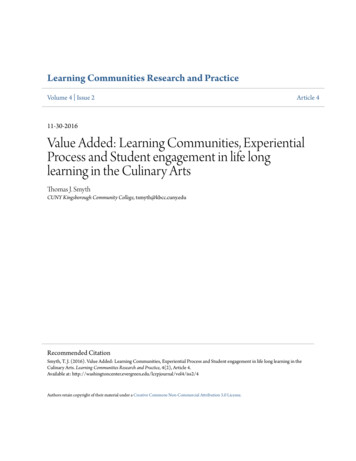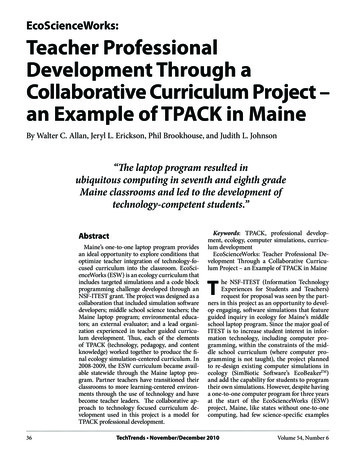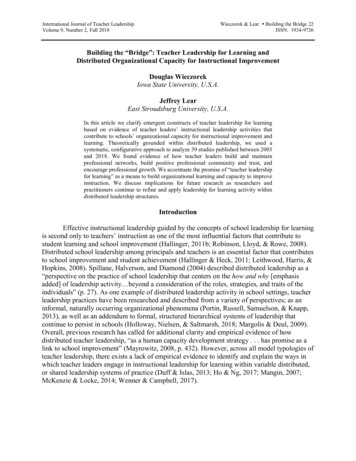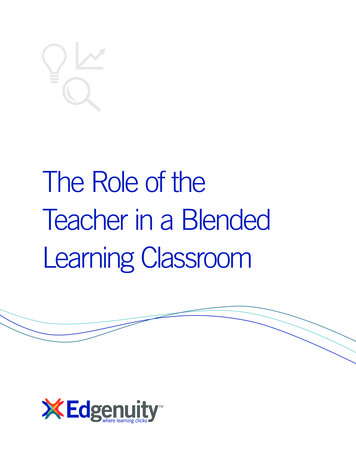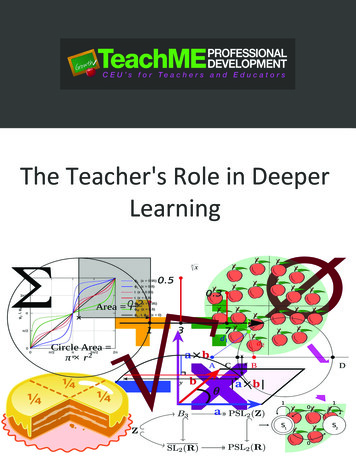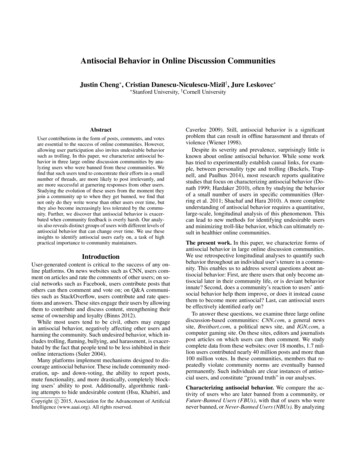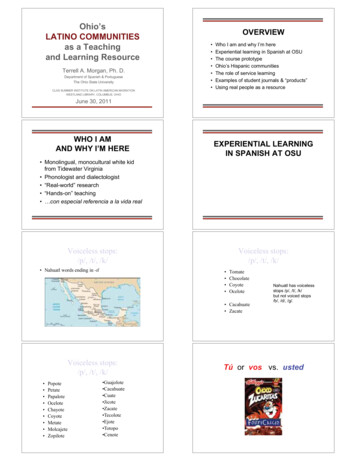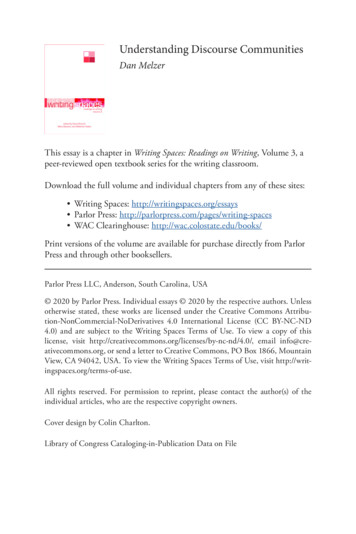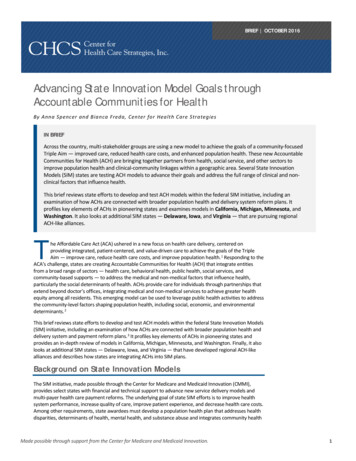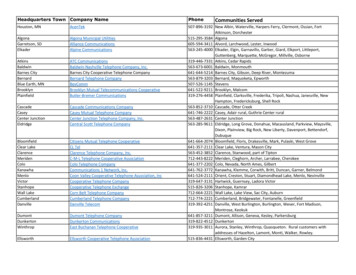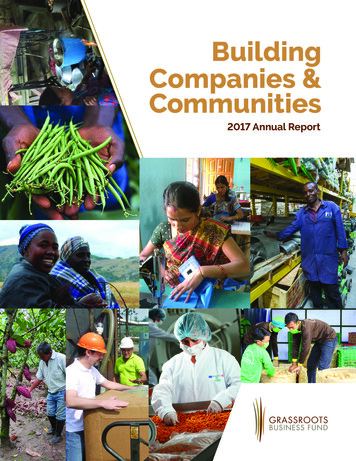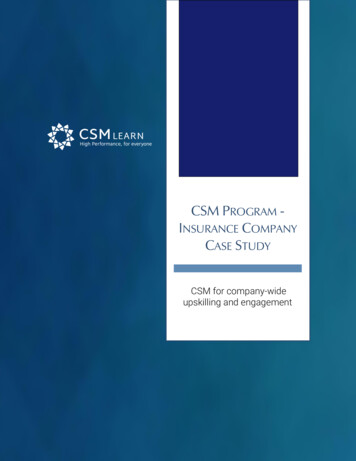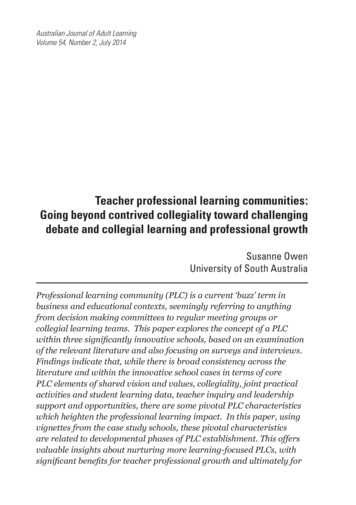
Transcription
Australian Journal of Adult LearningVolume 54, Number 2, July 2014Teacher professional learning communities:Going beyond contrived collegiality toward challengingdebate and collegial learning and professional growthSusanne OwenUniversity of South AustraliaProfessional learning community (PLC) is a current ‘buzz’ term inbusiness and educational contexts, seemingly referring to anythingfrom decision making committees to regular meeting groups orcollegial learning teams. This paper explores the concept of a PLCwithin three significantly innovative schools, based on an examinationof the relevant literature and also focusing on surveys and interviews.Findings indicate that, while there is broad consistency across theliterature and within the innovative school cases in terms of corePLC elements of shared vision and values, collegiality, joint practicalactivities and student learning data, teacher inquiry and leadershipsupport and opportunities, there are some pivotal PLC characteristicswhich heighten the professional learning impact. In this paper, usingvignettes from the case study schools, these pivotal characteristicsare related to developmental phases of PLC establishment. This offersvaluable insights about nurturing more learning-focused PLCs, withsignificant benefits for teacher professional growth and ultimately for
Teacher professional learning communities 55student learning.Keywords: Professional Learning Community, PLC, teacherprofessional learningIntroductionSocial, economic and political pressures are evident at a global levelregarding the key role of education in ensuring children and adultshave the skills and knowledge for living and working in a rapidlychanging world. High-level educational outcomes for students arebeing increasingly linked with quality teachers and there is a need forongoing professional learning to ensure that teaching practices areupdated within an era of considerable educational reform. Significantschool innovations include transformations in the role of learners andof teachers, organizational and pedagogical restructuring, and utilizingresources differently such as in terms of technology and learning spaces.There are generally also significant changes in curriculum content ininnovative contexts, including more interdisciplinary approaches andalso possibly including a focus on competencies and values (OECD,2011). The establishment of professional learning communities (PLCs)has been indicated as effective in building skills and knowledge forworking in innovative contexts across teacher and leader teams andnetworks, and also within online contexts and school and pre-serviceand postgraduate university study programs (Meiers & Buckley, 2009).The research literature indicates considerable consistency in the keycharacteristics of teacher PLCs. Participants working together regularlyover an extended timeline, shared values and vision, practical activitiesfocused on student learning, taking an inquiry stance, being reflectiveand collaborating and sharing experiences, are characteristics whichare consistently highlighted. Leadership support and opportunityfor distributed leadership within teams are additional characteristicsof many PLC models (Bolam, McMahon, Stoll, Thomas, Wallace &Greenwood; 2005; Johnson, 2009; Coburg & Russell, 2008; Scott,Clarkson & McDonough, 2011; Mockler & Sachs, 2002; Owen, 2005).Despite this apparent agreement and the proliferation of education
56 Susanne Owensituations which have established PLCs, closer examination of thecharacteristics highlighted by various researchers indicates thatthere are varying degrees of emphases. Understanding this mayhelp to account for the differential degrees of PLC impact on studentand teacher learning (Vescio, Ross & Adams, 2008). There are alsoframeworks which consider the developmental stages of PLCs, therebyenhancing understanding and providing insights for leaders and PLCteam members (Mulford, 1998; DuFour, 2004).This paper examines the PLC models and developmental stages in moredetail within the context of three highly innovative schools.Professional learning community background and theoretical modelsGreater understanding about PLCs may be contextualized withinsituated learning models and the communities of practice literature(Barab & Duffy, 2000; Lave, 1993; Wenger, 1998). In education, Barab& Duffy’s (2000) situated learning model or situativity theory is relevantbecause ‘colleagues work together on a real problem which involvesteam members in supporting each other scaffolding and breaking atask into manageable sections when issues are complex. [It involves]coaching, modeling, collecting data and examining student work highlighting cognition as distributed over people and artefacts’ (Owen,2004: 5). Barab and Duffy’s situativity theory or situated learningmodel highlights psychological and anthropological approaches. Thepsychological perspective is about cognition and meaning occurringthrough situated activities in practice fields resembling real lifesituations while the anthropological view is focused on learning withinactual communities of practice. ‘Meaning, solutions and interactionsgained ensure that the individual’s entity is inseparable from thecommunity and community members take responsibility for thelearning of others in the group’ (Owen, 2004: 5).The broadly-based community of practice literature is consistentwith Barab and Duffy’s situativity model, particularly within theanthropological focus. Authentic learner activities for the individual arelocated in community such that ‘developing an identity as a member ofa community and becoming knowledgably skillful are part of the sameprocess, with the former motivating, shaping and giving meaning to the
Teacher professional learning communities 57latter’ (Lave, 1993: 65)Lave (1993) and Wenger’s (1998) work regarding communities ofpractice, while not specifically focused on teachers, has particularrelevance to PLCs established in education settings. Wenger (1998)acknowledges the range of communities in which individualsparticipate on a daily basis but he defines communities of practice morespecifically. He uses three dimensions of purpose (joint enterpriseand values renegotiated by members over time); functions (mutualengagement binding long term members and newcomers into a socialentity and commitment to shared ideas); and capability (sharedrepertoire of communal resources including artefacts produced overtime). Knowledge is created, shared, organised, revised and passed onwithin and among these communities. In a deep sense, it is by thesecommunities that knowledge is ‘owned’ in practice’ (Wenger, 1998).While Wenger and Snyder (2000) highlight that Communities ofPractice arise naturally and are essentially self-sustaining in nature,Wenger (1998) also indicates that there are considerable processesinvolved in leadership nurturing of the community. Support processesinclude creating time for member activities and nurturing a collegial andlearning-focused culture. Other supports include provision of resourcesincluding involving outside experts and funded conferences and studyprograms to continue to bring in new ideas and guard against insularity.Another significant aspect relevant to the anthropological perspectiveis the concept of reproduction of the community as new members workalongside competent others in the community of practitioners. Lave(1997) indicates that newcomers within these communities begin asapprentices on the periphery and gradually move towards the centreof the community as they acquire the beliefs of others. This results inindividual values and practices becoming merged with those of thecommunity. However there is more to the process than newcomersbeing continuously inducted into the existing group over an extendedtimeline because they also bring in new ideas. This helps to ensure thatregeneration and ongoing learning is occurring.Teacher PLC frameworks backgroundTeacher professional learning community models are closely aligned
58 Susanne Owento the community of practice literature involving characteristics ofcollegiality, practical tasks with a focus on student learning, and beingresearch-oriented for the purposes of improving practice. These aspectsare reflected in the following definitions of professional learningcommunities: small groups of teachers who come together as a team to help oneanother improve student learning. The team members share andreflect on their practice and personal experiences, observe eachother’s practices, and study and apply research and best practicestogether (Education Northwest, 2012: 3, citing Sather & Barton,2006). a group of people who take an active reflective, collaborative,learning-oriented and growth-promoting approach towards themysteries, problems and perplexities of teaching and learning(Edwards, 2012: 26, citing Mitchell and Sackney, 2000).Scott, McDonough Clarkson’s (2011) literature review of keyelements regarding teacher PLCs generally highlights consistency ofcharacteristics. Their work focuses on four researchers (Bolam et al.,2005; Johnson, 2009; Darling-Hammond & Richardson, 2009; Coburg& Russell, 2008). All of these researchers characterise teacher PLCsas explicitly or implicitly being about shared values and vision, a focuson student learning, taking an inquiry stance, making teaching morepublic, sharing experiences and expertise, willingness to experimentwith alternative strategies, and engaging in reflective dialogue.Having collective responsibility for pupil learning, attending to schoolteaching-learning challenges, and having inclusive membership andmutual respect and support for teachers were other PLC characteristicsidentified by most of these researchers. However, goal setting anddesigning action plans, having formal and widespread leadership, andengaging in-depth interaction about how students learn (regardingcontent, pedagogical principles, curriculum content) were PLCcharacteristics noted variously by only one of the four researcher teams.Consistent with community of practice features outlined previously,the leadership aspect is of particular interest, especially for school-
Teacher professional learning communities 59based PLCs. This aspect incorporates support from leadership for PLCs,the notion of distributed leadership and the role of team members inbuilding their own leadership skills and those of others in their group.Kruse, Louis and Bryk’s (1995) work generally aligns with previouslyoutlined teacher PLC characteristics in terms of reflective dialogue, trustand respect, shared norms and values, and collaboration and collectivefocus on student learning. However their work also specificallyhighlights many aspects associated with leadership support such as‘supportive leadership’, ‘deprivatisation of practice’ (eg observingteaching and formal methods to share expertise and support marginalteachers), ‘socialisation and support for new teachers’, ‘time to meetand talk’, ‘teacher empowerment’ and ‘establishing communicationstructures’. Similarly, DuFour’s (2004) model is consistent with thepreviously-outlined PLC characteristics but particularly emphasisesleadership support and teacher empowerment. The model has asignificant focus on goal setting, continuous improvement and ensuringthat students learn, also data and results.Beyond student learning, teacher professional learning throughcollaboration is a key characteristic in each researcher’s list ofcharacteristics, although with details being made more explicit in somemodels. For example, DuFour’s (2004) model additionally emphasisesaction research and also collective professional learning as a keycharacteristic of the PLC, including provision of some very specificdetails within a rubric. Other researchers (Hargreaves, 1992; Head,2003; Grossman, Wineburg and Woolworth, 2000, 2001; Jarzabkowski,2001) also provide a similar focus about supporting professionallearning through collaboration. They caution that collaboration basedon contrived collegiality, conviviality and congeniality may be animpediment to professional learning. There are challenges for workingin a professional learning community which deprivatises teaching andis characterised by common goals and builds interdependence. The keyis building a culture which goes beyond the work group and is open tonew ideas and guarding against insularity. Continuous professionallearning and debate is essential (Stoll et al., 2006; Fullan, 1993).Grossman et al.’s (2000, 2001) work documenting the formation ofan interdisciplinary secondary teacher PLC indicates key aspects ofprocesses in collaborative professional learning. Challenge and debateregarding various educational perspectives are an important part of the
60 Susanne Owenlearning process.Indeed, several researchers highlight that PLCs do not just happenbecause teachers are working together and there are actuallydevelopmental phases. Mulford (1998) summarises the predictablestages of group development as ‘forming’ (polite), ‘storming’ (conflictover power), ‘norming’ (social cohesion and willingness to share),‘performing’ (increase in task orientation and feedback), ‘transforming’(group learns from feedback and may change tasks or ways of doingthem), ‘dorming’ (resting to prevent burnout) and ‘mourning’ (groupdissolution). Mulford (1998) also emphasizes the important roleof the school leader to ensure that PLCs go beyond the ‘forming’,‘storming’ and ‘norming’ phases and really focus on ‘performing’ and‘transforming’ stages. Similarly, Du Four’s (2004) work has ‘preinitiation’, ‘initiation’, ‘developing’ and ‘sustaining’ stages, with asignificant leadership aspect included. For example, for the ‘actionresearch’ PLC aspect (a key focus for teacher inquiry and professionallearning), the pre-initiation stage is about individual teacher classroomexperimentation without training, support structures and evaluationprocesses. However, at the
Australian Journal of Adult Learning Volume , Number , July 1 Teacher professional learning communities: Going beyond contrived collegiality toward challenging debate and collegial learning and professional growth Susanne Owen University of South Australia Professional learning community (PLC) is a current ‘buzz’ term in business and educational contexts, seemingly referring to anything .
